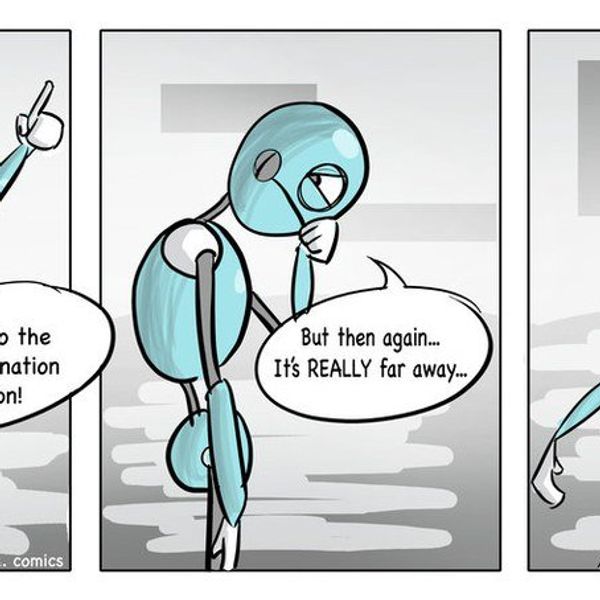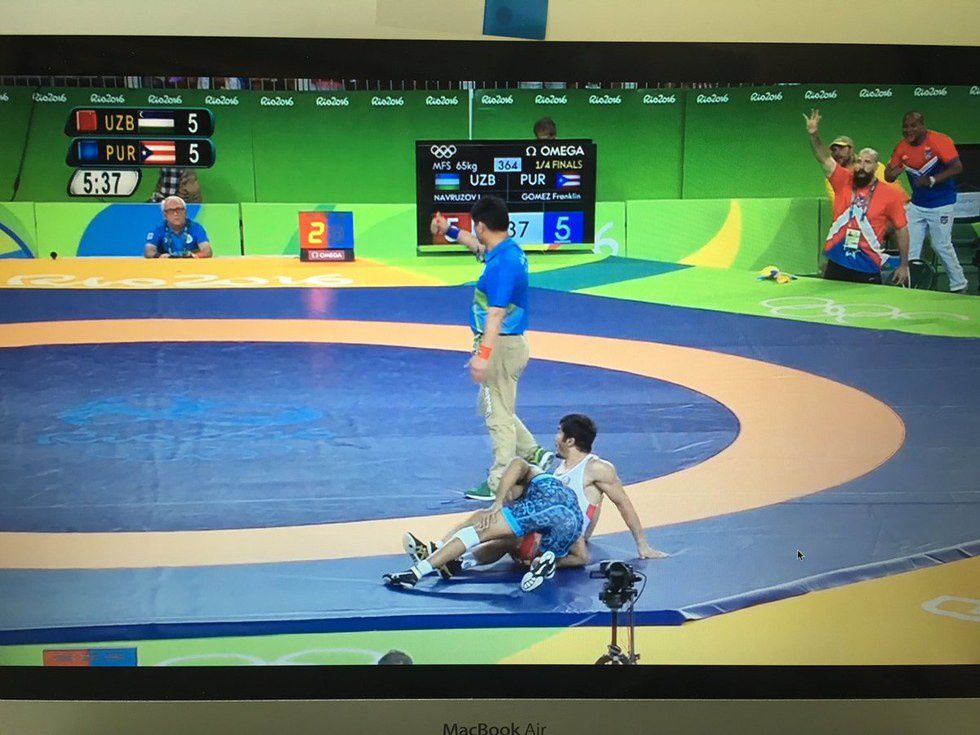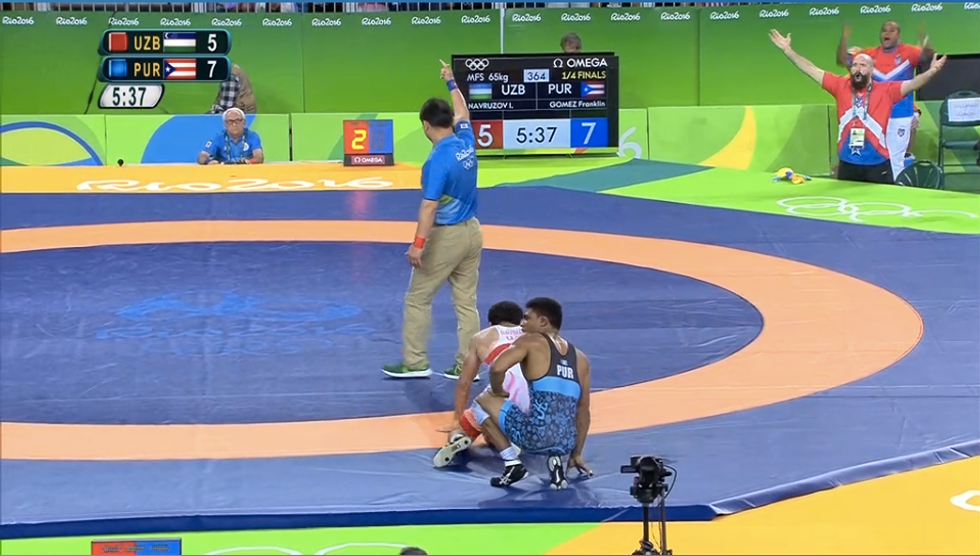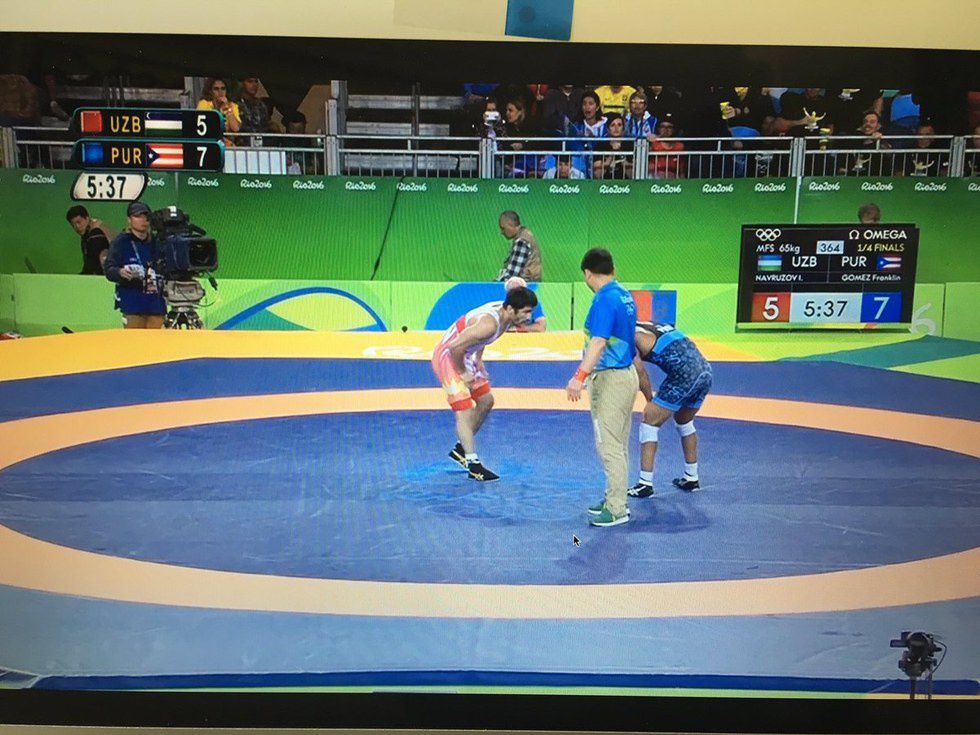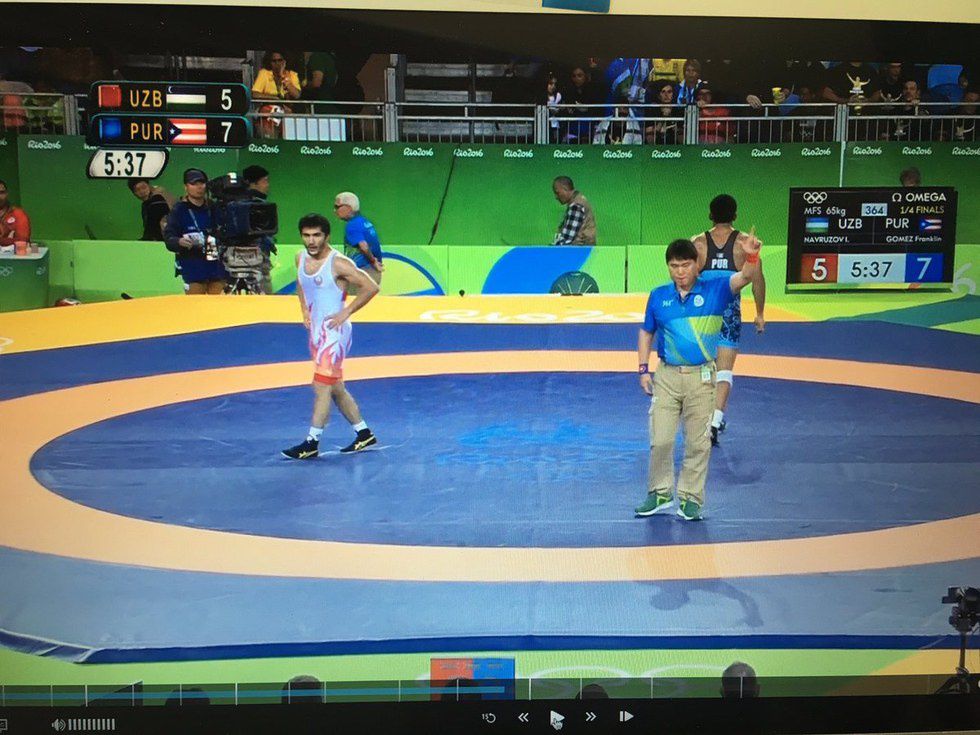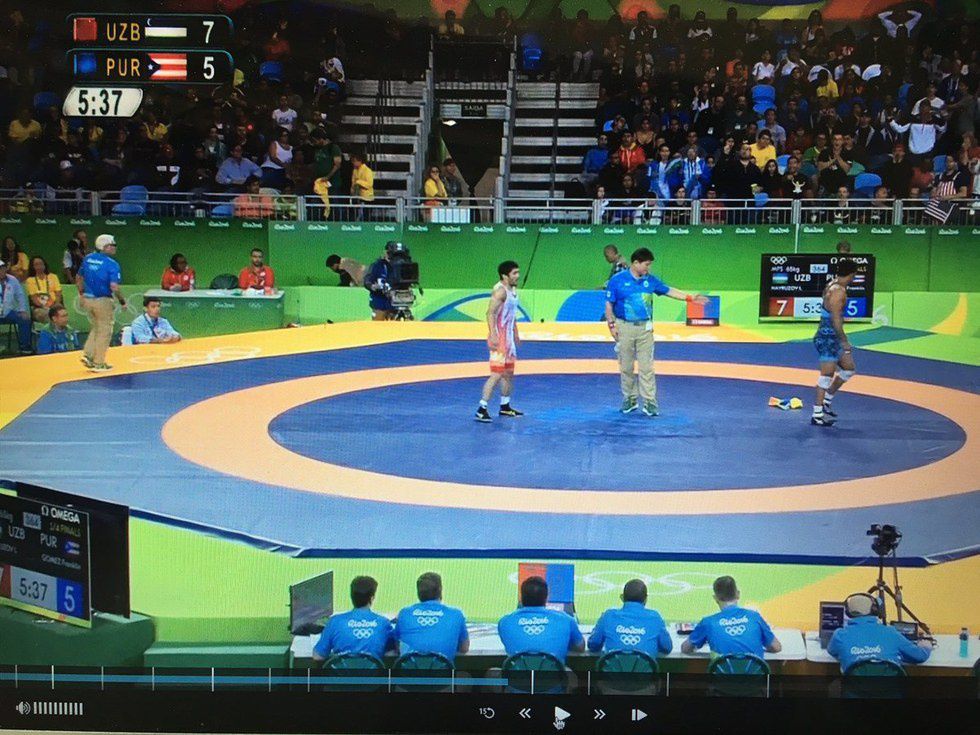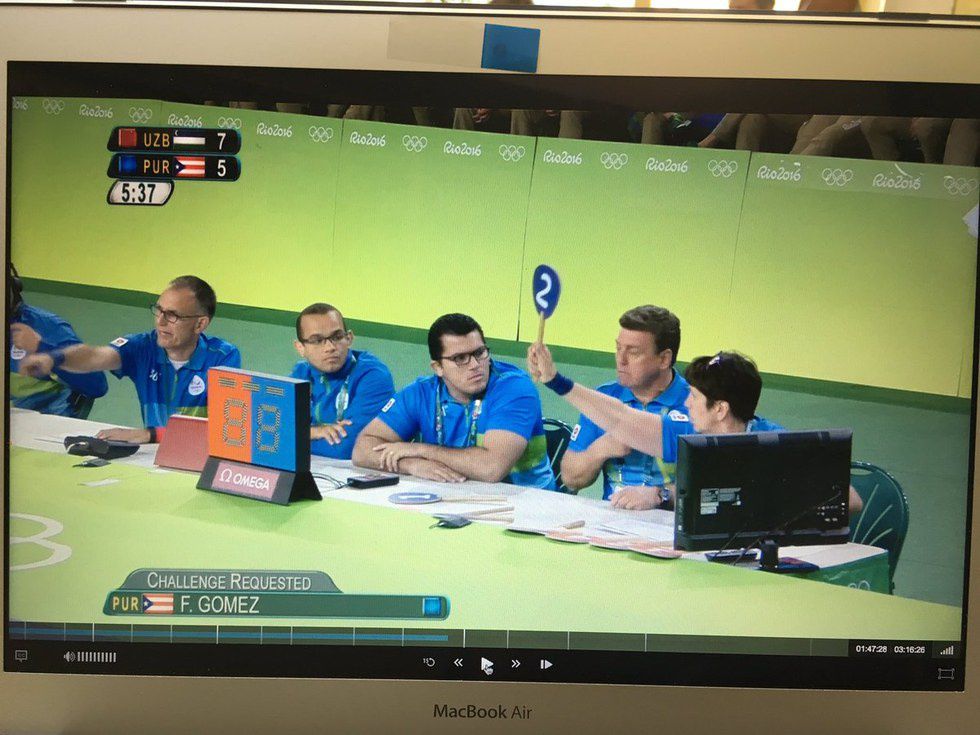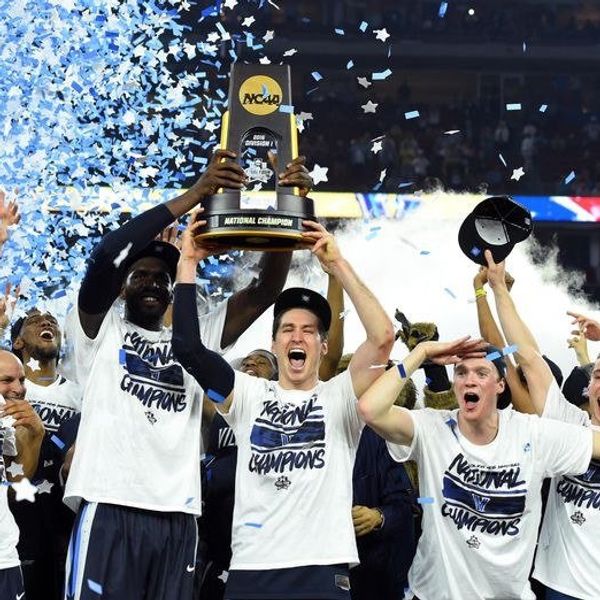2016 Olympic Quarter-Finals: 65KG Franklin Gomez (PUR) vs Ikhtiyor Navruzov (UZB)
This is easily one of the most controversial calls of the Olympic Wrestling tournament this year. Many in the American wrestling community have been outspoken in their outrage for what has been called a “screwjob” against Franklin Gomez, who represents Puerto Rico but is known by American fans for being an NCAA Champion in 2009 for the Michigan State Spartans, as well as currently training with the Nittany Lion Wrestling Club out of Penn State. The match in question is a Olympic Quarter-final match in the Men's Freestyle 65KG weight-class, which coincided with the last day of competition. 2011 World Silver Franklin Gomaz faced Ikhtiyor Navruzov, the 2015 World Silver. Nonetheless, legendary wrestler and current Head Coach of the Penn State Wrestling team Cael Sanderson was outraged by the call.
Franklin Gomez got straight up cheated. What a shame and disgrace.
— Cael Sanderson (@caelsanderson) August 21, 2016
As was 2008 Olympian and ONE FC Welterweight Champion Ben Askren.
100%. Someone should be held accountable https://t.co/VCH8qy2BnW
— Ben Askren (@Benaskren) August 21, 2016
In fact the call was so egregious, Brent Metcalf (who, I’d say, was the victim of similar shadiness in a match against Franklin Gomez at the 2016 Pan-American Olympic Games qualifier) spoke out against the call in the match!
Wow! That was bad @wrestling! Table ref changed video the challenge call! Bad! Bad! All for us to see!
— Brent Metcalf (@BHMetcalf) August 21, 2016
UnitedWorldWrestling issued a statement within a hours of the incident, removing three officials calling the match from the tournament as well as removing them from “refereeing responsibilities” pending an investigation. These officials include the referee, the judge, and (presumably) a juror.
The Sequence and Officials’ Calls
Regardless of how you feel about the call, it’s necessary to have an objective, clear description of not only the sequence of wrestling that is in question, but also the original calls made by the officials, in the deed. To quickly orient the casual viewer, UnitedWorldWrestling sanctioned events use a three-official system, which includes a referee, the main official that is physically on the mat; the judge, a second official that confirms or disputes the calls made by the referee; and the mat chairman, a third official that overlooks both the referee and the judge (see: Wrestling Rules (March 2016 Version) Chapter 4, Article 16). The three-official system in practice makes it such that all calls made during a given match are made such that two out of three officials agree. It is designed to remove the subjectivity of matches to ensure the correct wrestler is awarded points.
There is also a two-person crew called the “Jury of Appeals”. The “jury” is important in the instance of a challenge by a wrestler and their coach over a specific call. The jury reviews the video and makes a “unanimous agreement” between the two of them. Of the two jurors, one is the “coordinator” that is in charge of expressing the opinions of both members of the jury.
From Wrestling Rules Chapter 4, Article 22:
During the video review, the Jury of Appeal will render its decision without consulting the refereeing body. If the Jury of Appeal reaches a unanimous agreement, it will be considered final and irrevocable. No further appeal will be possible.
(my emphasis added)
From Wrestling Rules Chapter 5, Article 33:
After having reviewed the action, the Jury of Appeal renders its decision first. The Jury of Appeal intervenes and renders its decision in all cases. A unanimous decision by the Jury of Appeal will be final and may not be discussed. If the members of the Jury of Appeal disagree, another review of the action will be requested. Then the majority decision of the Jury of Appeal and the refereeing body will prevail.
(my emphasis added)
Make note of the emphases. These points of regulation will become very salient as we go through the sequence itself.
Just watched again #disgusting So Gomez scores then it's like they have a discussion to see who they want to win. pic.twitter.com/baMzJ1B6zz
— Cliff Fretwell (@knarkill) August 23, 2016
It is imperative that you watch the video linked in the above tweet, as it shows the complete sequence of action in question. As one can see through the clip, Franklin Gomez, in the blue, is in on a double-leg takedown (a very tight one I must add, as he has his hands completely locked around both of his opponent’s legs) against Ikhtiyor Navruzov, in the red. As the action moves toward the edge of the mat, Navruzov’s back hits the mat flatly as he attempts to hit a chest-wrap roll-through to expose Gomez’s shoulders for a 2pt exposure for Navruzov. Gomez continues to wrestle and clearly completes a takedown for at least 2pts for himself.
Immediately after the sequence ends, the referee puts up, first, a 1pt Blue (1B), which becomes a 2B a second after (as seen in the first two images). The judge (on the far-side of the mat) calls 2R. At this point 2B appears on the scoreboard, either implying the mat chairman agreed on 2B with the referee (meaning two out of three officials called 2B) or the table-help put the points up after seeing the referee award the points.
A short conference between the three-official group convenes and the score changes from 2B to 2R. The referee appears to backtrack from his initial 2B to 2R. At this point, Blue’s corner throw in the challenge indicator.
Remember, during a challenge, the jury, not the three-official referee system, makes a decision “without consulting the refereeing body.”
The above screenshots show two separate instances in which the 2B paddle was raised by the coordinator. In the first instance, as seen on the stream, the other juror stops her as he tells the coordinator he does not agree with the call, i.e., that he believes the sequence should be scored 2R, while the coordinator (who is in charge of the paddle) scores 2B. As the jury argues, the mat chairman, who is not to consult in the decision-making process in light of the challenge and honestly doesn’t seem to, “asks” the coordinator for the decision. As the coordinator and juror clarify their difference in opinion, the juror calls for a conference with the referee and judge (in addition to the mat chairman who is seated down the table from the jury). The mat chairman, incorrectly, tells the juror, “you cannot ask [the referees], you must decide.” This statement seems in reference to the fact that challenges must be conducted by the Jury of Appeals alone, unless the two jurors disagree (which they did in fact, disagree). At this point, the coordinator again puts up the 2B paddle as seen in the second image above. The paddle is ignored as the three-referee body and the jury convene, which is correct under the rules as a majority-decision is the end-all if the jury cannot agree between themselves.
As one can hear on the feed, all five officials were asked to give their opinions. The referee, judge, and juror call 2R. The coordinator and mat chairman call 2B. 2R is the call after a 3-2 majority of opinions. 1R is further awarded for a failed challenge. Gomez would go on to lose the match 8-5, this particular sequence being the match decider.
The Interpretation
As a "somewhat intelligent fan", I see one of these:
1) 4B, 2R feet-to-back +continuation
2) 2B, 2R exposure-expos+cont
3) 2B expos or TD
— The Quoter (@WrestlingQuoter) August 22, 2016
Now, we know that the 2pts Red call was made by a slim majority over the 2pts Blue call. Let’s get into the logic of the sequence and what you could call it in terms of points. I am not an expert. My freestyle experience was pre-2013 rules (the “best-of-three” or “ball-draw” era), at the high school level. I haven’t read the entirety of the rules (yet) but have watched quite a bit of matches since 2011. In any case, take it for what it’s worth. Note that my interpretations are options that I could believe, not that I endorse.
Per the above tweet, my interpretations for how to score the sequence are similar, with a slight deviation on option (2) with additional other options:
- 4B, 2R
- 2B, 2R, 1B
- 2R, 2B
- 2B
- 1B
One of the biggest factors in this sequence is the fact that it started but finished out of bounds. Another factor is the philosophy of continuation. Now, “continuation” is a common term for the when (a) a scoring sequence/ action continues even after the :30s mandatory-score period elapses and the match is not stopped or (b) a wrestling move/ hold that started in-bounds continues out-of-bounds and a score is still given. I infer that continuation is part of awarding the offensive wrestler.
Let’s establish that the action definitely started inside the circle and progressed to the edge of the mat (passivity zone) as Blue drove Red on a double-leg. Red shot initially before Blue achieved a rear-standing position to which Red turned in whilst running. As Red turns in, Blue locks his arms around his opponent’s knees, pulling the legs in to bring his opponent down. Red, as he’s falling (or sitting), locks his arms around Blue’s chest and kicks with his (Red’s) right leg. Red definitely elevated blue pretty high, but it is unclear if exposure was ever achieved. What is clear is that Red had his back exposed. By the end of the sequence, Blue had recovered position and finished in control with Red in danger (seated with hands posted behind him to elevate his torso).
- 4B, 2R: this interpretation is based in the fact that Blue was the aggressor as the action moved to the zone. Because Blue was in on a takedown and Red went straight to his back (albeit, out-of-bounds), one could argue that Blue scored a feet-to-back 4B takedown and Red scored on the roll-through for 2R as the action went out-of-bounds.
- 2B, 2R, 1B: here, the aggression is still awarded, but not as much. 2B is awarded as Blue “exposes Red’s back” (instance in which Red sits back), 2R is awarded as Red hits the roll-through, and 1B is awarded when Blue recovers position to end of the action.
- 2R, 2B: this option implies that one believes Red stopped Blue’s motion and took over the sequence, initiating the roll-through with full control of the momentum to score 2R first. 2B would then be awarded as Blue not only finished the initial takedown motion, but finished with Red in danger. This interpretation may be the closest to the official decision of only 2R.
- 2B: this option takes a stricter approach to the end of action out-of-bounds. 2B could be awarded if the officials considered the action to have been initiated by Blue, but stopped once both wrestlers were, though airborne, out of bounds. In this case, Blue was in position for a 2pt takedown.
- 1B: this is the strictest interpretation of the out of bounds factor. In this case, the continuation factor is minimized as the action is ruled to be such that Blue drove Red out of bounds, stopping the action, regardless of what happened after.
So what about the 2R call? The call could only be justified if Red is being seen to display control of Blue’s motion and hit the roll-through (see option (3)) to expose Blue. It would seem three of the five officials (the combination of three-person refereeing body and two-person jury) deemed Blue’s post roll-through action out of bounds, ignoring continuation. It would seem that the three-deciding officials believed Gomez had touched his head out of bounds before the roll-through, but that would mean both men were out of bounds by this point… The argument is flimsy. It’s hard to defend the interpretation when I don’t agree with it. How continuation could be given to Navruzov but not Gomez is a point of contention. Why a takedown wasn’t awarded for the initial move toward the edge is as well.
What’s clear is 2B went up on the scoreboard first as the mat chairman and the referee agreed initially on 2B. But after the jury couldn’t unanimously agree, the decision became a best-of-five decision, in which the referee changed his initial opinion from 1B/2B to 2R. Corruption? I don’t know. What I do know was, for all intents and purposes, the wrong call was made. Before you think UnitedWorldWrestling has fallen back to it’s tricks of the past (*cough* FILA *cough*), consider this. The mat chairman, it appears, called 2B in agreement with the referee’s original call. The judge calls 2R.
From Wrestling Rules Chapter 6, Article 41:
The referee shall indicate his decision by raising his arm and clearly showing the points with his fingers. If the referee and judge agree, the decision is announced. The mat chairman is not entitled to influence or change a decision if the referee and judge are in agreement except if he calls for a consultation or after a challenge.
(my emphasis added)
If everything was done in earnest, the mat chairman stuck to his guns when he gave his opinion of 2B during the challenge. Thus the battling opinions became 2B or 2R with other interpretations either not considered or ruled out wholesale. When the referee, judge, and a juror decided on 2R, they prevailed. The procedure, though barely, may have indeed been followed correctly, but the three officials were so blindingly wrong on 2R that they were handed suspensions. It's very possible that there was funny-business going on, as this was not the only incident of questionable officiating during this wrestling tournament.
We’ll have to see what lies ahead as UnitedWorldWrestling recovers from the Olympic week of non-stop wrestling with an investigation. The officiating of the Games have brought the World’s eyes to the oldest Olympic sport that is still so vulnerable as it flee its ghost of rampant corruption. For Franklin Gomez, there will be no solace. But perhaps this incident may force transparency to protect future wrestlers.
Catch up on the Olympic Games below!

